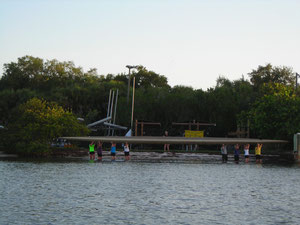Introduction to rowing:
The boat is almost 60 feet long and only 20 inches wide. We're sitting with our backs to the bow, or the front, of the boat. The oars alternate left and right, four on each side in an 'eight'. Only the coxswain, the 'cox', sits facing forward and controls the rudder. The oars are the propulsion and also the brakes, if needed. They also provide the balance for our skinny boat.
High tech:
The boat and the oars are made of the lightest, strongest materials available. The design is all about one thing; speed. The seats roll on tracks so we can use our large leg muscles to propel the boat faster than arms alone.
Close quarters:
We sit close behind and in front of the next rowers. No one can 'drive' or pull their oar while another is 'recovering' or pushing theirs. There is only room for coordinated movement, every rower closely following the motion of the rower in front of them.
Continuous learning:
We never stop learning to improve our stroke. The boat moves fastest and easiest if all the rowers move in unison with each other. Like a ballet the best rowers flow together and make it look easy and smooth. We continually strive for that perfection, that no one ever truly achieves. You'll complete 'learn to row' and 'novice', then enter the club rowing schedule but you'll always be learning to make the boat move faster and smoother with improved strokes and timing of your body and the oar. You can learn to row in a few weeks, but it takes longer to get good at rowing. Some of our members have made several million strokes, and they still work to refine their technique.
 Lemon Bay Crew Club
Lemon Bay Crew Club

